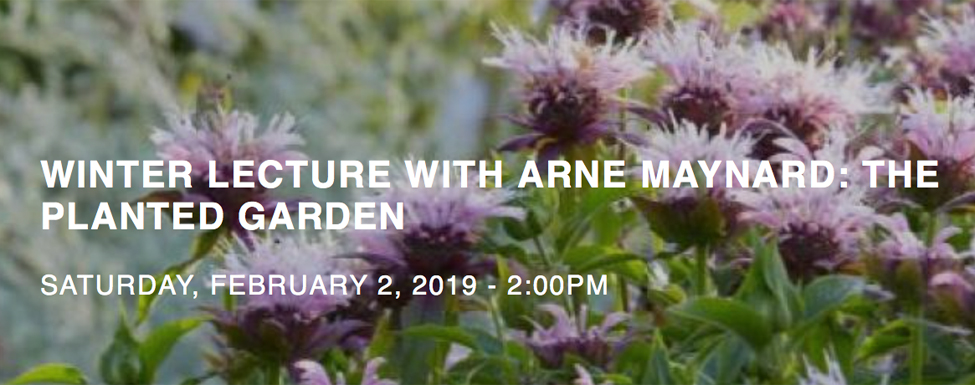The Planted Garden
The itch is building. The holidays are past, the days are growing longer and, despite the occasional dip into single-digit temperatures, gardeners can almost feel the loam crumbling beneath their fingertips.
What to do until that moment becomes a reality? A partial antidote could be found in the Winter Lecture planned by the Berkshire Botanical Society. Set for February 2nd, the lecture on “The Planted Garden” will be given by famed UK gardener, Arne Maynard, and is set for 2PM in Duffin Theater at Lenox Memorial Middle/High School, 197 East Street, Lenox.
An international garden designer, Maynard works with clients across the world, working on everything from medieval manors in England to creating a modern garden in the Middle East—his most difficult challenge to date. Central to his work, he says, is his ability to identify and draw out the essence of a place, imbuing his gardens with a quality of harmony and belonging.
Maynard traces his interest in gardening back to his young childhood when he would follow his grandfather as he weeded his vegetable garden in Dorset. Maynard recalls being distressed as his grandfather thinned out young carrots, throwing them on the compost heap. His attempts to rescue the carrots went for naught but, by the time he turned 7, young Maynard had the job of looking after the school garden. Throughout his youth he earned his pocket money gardening and mowing lawns, usually working alongside elderly people.
As his interest grew, it was nourished by his godmother, who regularly took him to local gardens of interest. His passion for design was awakened in Lady Salisbury’s garden at Cranbourne Manor. “This is a wonderful old hunting lodge nestled in the Dorset hills, close to the ancient Cranbourne Chase, a royal hunting ground from at least the time of William the Conqueror until the seventeenth century,” he has written. “A thrill ran through me the first time I ever saw the view through the main gate, down the magnificent avenue of mature beech trees that leads to the house. I was bowled over by the beauty and atmosphere.”
Despite having grown up gardening, Maynard was pushed into studying architecture, a choice that did not stick. “I yearned to be outside,” he has recounted, “and while an appreciation of structure and buildings is essential in garden design, my passion has always been horticulture and plants over architecture.”
He established a garden design practice in London in 1990 and works with a small professional team on a wide range of projects, from tiny urban gardens to large country estates, both in the United Kingdom and abroad. He enjoys creating highly individualized plans that reflect not only the property owner’s taste, but also their lifestyle and home.
"I'm there to gather the information from the client and mentally file it and then rewrite it in a way that gives them a garden that's theirs but that still belongs to the property and the location," he says.
He likes bold lines and a strong architectural framework, using hedges and walls to divide gardens into separate spaces and to give a sense of permanence. To counter-balance the formality imposed by these structures, Maynard often uses herbaceous flowers and roses that are casual, lush and expansive to soften the effect.
When designing a new garden for a Tudor-era hall in north Norfolk, for instance, he found only minimal remains of the original Elizabethan garden. The owners did not want to recreate the historic garden but rather to have something new with echoes of the historic past. Maynard solved the problem by putting in steps to physically link the three main areas of the garden but also designed elements that visually drew the garden together. Topiary and oaks were used in different ways throughout and were softened with wild flowers or musky herb and herbaceous under-planting.
In another instance, he created a new vista for a Norman manor house. The front was previously dominated by a parking space but he moved the cars away, creating a front court framed by the garden. A line of pleached crab apples (pleaching consists of weaving the branches of a line of trees) make a visual division between the drive and the garden.
Finishing the polished appearance, a limestone chipping surface is planted with low box hedges that form a crisscross pattern—a contemporary version of a knot garden—which is peppered with aromatic lavenders and sages. Oxeye daisies are planted above the line of hedges and in between the sculptural, clipped topiary shapes that punctuate the knot.
There is limited seating for the Winter Lecture so advance registration is highly recommended. Admission is $35 for members and $45 for non-members. Walk-ins are welcome, space permitting. A post-lecture reception and seated dinner for 30 people is scheduled for that evening, 6-9PM in the Center House Carls Dining Room. The cost is $150 for members and $175 for non-members. Go to www.berkshirebotanical.org/events.
In addition to the winter lecture, the Botanical Society has planned a full series of programs for February. Tree Care for Gardeners is slated for Fridays, February 1st-15th, 1-5PM; Sustainable Landscape Care & Garden Maintenance will be offered on Tuesdays, February 5th-26th, 5:30-8:30PM; Baking with Ancient Grains is set for Saturday, February 9th, 10AM-1PM; Native Perennial Seed Starting, February 9th, 11AM-2PM; Berkshire Backyard Beekeepers, February 12th, 6PM; Raising Nucs: A Valuable Skill for All Beekeepers, Saturday, February 16th, 10AM-noon; The Genus Geranium: Hardy Cranesbills for Every Garden, February 16th, 2-4PM; and finally, Maple Sugaring at Home, February 23rd, 10AM-12:30PM.

